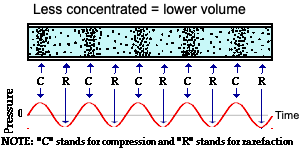 Technology
Technology
 Sound
Sound
 Sound - Loudness
Sound - Loudness
Don's Home
 Technology
Technology
 Sound
Sound
 Sound - Loudness Sound - Loudness
| Contact |
 Under Construction. Under Construction.See also: Sound Frequency | Sound Loudness Audio - stereo - Home Theater (Surround Sound) in home and garden. Frequency Response Specs Subwoofers What is SoundSound is a mechanical wave that results from the back and forth vibration of the particles of the medium (air, water, wook, ...) through which the sound wave is moving.There are regions in the air where the air particles are compressed together (compressions) and other regions where the air particles are spread apart (rarefactions). The compressions are regions of high air pressure while the rarefactions are regions of low air pressure. The greater the difference between the high air pressure and low air pressure is the loudness. Sound waves are sometimes represented by a pressure graf. They may look like ocean waves with an up and down motion, but they do not move up and down. The graph represents pressure not distance. The differences between the high and low pressure is loudness. A big difference or the higher the graph is a loud sound. The distance between the waves are represents frequency. Close = high frequency, spread out = low frequency. How closely they are packed together represents volume.  
Sound loudness measurementThe greater the difference between the high air pressure and low air pressure is the loudness.Sound waves are sometimes represented by a pressure graf. They may look like ocean waves with an up and down motion, but they do not move up and down. The graph represents pressure not distance. The differences between the high and low pressure is loudness. A big difference or the higher the graph is a loud sound. The unit measure of SPL (Sound Pressure Level) is decibels (dB). It is measured with a Sound Pressure Level Meter. Sound is a mechanical (not electrical) wave that results from the back and forth vibration of the particles of the medium through which the sound wave is moving.
Loudness is measured in decibels (dB). A decibel is one tenth of a bel, a seldom-used unit named in honor of Alexander Graham Bell.
A-weighted decibels, abbreviated dBA, or dBa, or dB(a), are an expression of the relative loudness of sounds in air as perceived by the human ear.
__________________________________________________________________
A-weighted decibels, abbreviated dBA, or dBa, or dB(a), are an expression of the relative loudness of sounds in air as perceived by the human ear. LOUDNESS OF SOME SOUNDS
Acceptable Noise - dBA - Levels The speed of a sound wave depends upon the medium the wave is moving through. Sound moves faster through dense materials such as wood or metal because the molecules are close together. Sound also moves faster through warmer materials because the molecules of a warm substance are colliding more often than the molecules of a cold substance.
| |||||||||||||||||||||||||||||||||||||||||||||